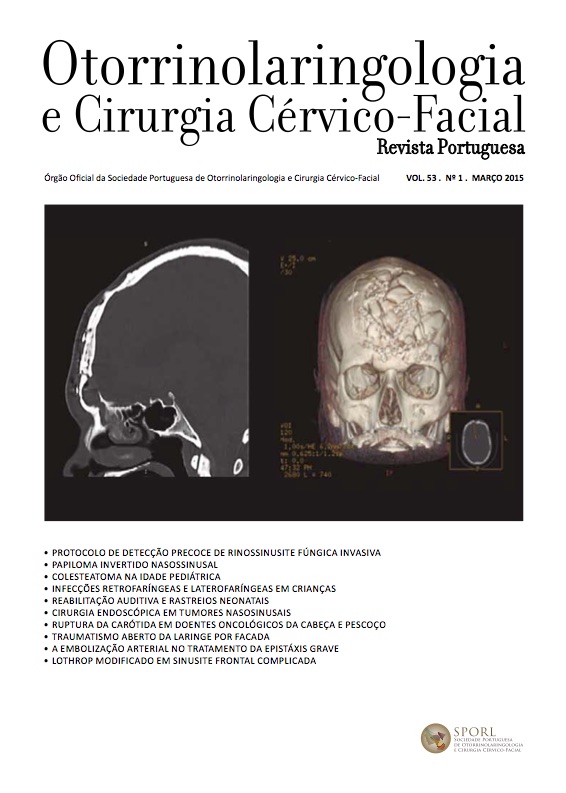Early detection protocol for acute invasive fungal rhinosinusitis
DOI:
https://doi.org/10.34631/sporl.555Keywords:
early detection, acute invasive fungal rhinosinusitis, protocolAbstract
Introduction: Invasive fungal rhinosinusitis is a nosologic entity with increasing prevalence. This tendency is mainly due to a larger number of immunosuppressed patients. Despite the progress in medical and surgical treatment, mortality rate is still high in acute Invasive fungal rhinosinusitis, ranging from 20 to 80%. The authors present a multidisciplinary protocol for a precocious intervention in immunosuppressed patients with suspected acute Invasive fungal rhinosinusitis.
Material and Methods: The articles analyzed in this review were identified through a systematic survey, conducted in PubMed. We selected 18 articles published between September 1993 and January 2014. Were included articles that could be analyzed for host factors that predispose to RSFIA, and for the early signs and symptoms that lead to suspicion of disease. For the diagnosis and treatment were used “guidelines” and international consensus.
Results: The neutrophil dysfunction seems to be a cross predisposing factor to virtually all patients who developed RSFIA. Fever and / or local symptoms (swelling and facial pain, nasal obstruction, rhinorrhea, headache) are considered the earliest symptoms, and pale mucosa, slightly crumbly, edema, granulation and crusts are considered the earliest signs of RSFI. The imaging tests most commonly used for the initial evaluation of patients with suspected RSFI is the TAC SPN. The RSFIA diagnostic criteria are defined by the groups ISHAM and EORTC / MSG-NIAID. Treatment includes correcting the immunodeficiency, medical therapy with systemic antifungal and surgical debridement.
Conclusions: The authors present a protocol for identification and treatment of patients with acute invasive fungal rhinosinusitis.
Downloads
References
Thompson GR, Patterson TF. Fungal disease of the nose and paranasal sinuses. J Allergy Clin Immunol. 2012 Fev;129:321–326.
Chakrabarti A, Sharma C. Paranasal Sinus Mycoses. Indian Jchest Dis Allied Sc. 2000; 42:293-304.
DeShazo RD, Chapin K, Swain R. Fungal sinusitis. N Eng J Med. 1997;337:254–259.
Chakrabarti A, Denning DW, Ferguson BJ, Ponikau J, et al. Fungal rhinosinusitis: a categorization and definitional schema addressing current controversies. Laryngoscope. 2009;119(9): 1809–1818.
PariKh SL, Venkatraman G, DelGaudio JM. Invasive Fungal Sinusitis: A 15-year Review from a Single Institution. Am j Rhinol. 2004;18:75-81.
Turner JH, Soudry E, Nayak JV, Hwang PH. Survival Outcomes in Acute Invasive Fungal Sinusitis: A systematic Review and Quantitative Synthesis of Published Evidence. Laryngoscope. 2013 May;123(5):1112-8.
DelGaudio JM, Clemson LA. An Early Detection Protocol for Invasive Fungal Sinusitis in Neutropenic Patients Successfully Reduces Extent of Disease at Presentation and Long Term Morbidity. Laryngoscope 2009 Jan;119(1):180-3.
Gillespie MB, O’Malley BW Jr, Francis HW. An approach to fulminant invasive fungal rhinosinusitis in the immunocompromised host. Arch Otolaryngol Head Neck Surg. 1998 May;124(5):520-6.
DelGaudio JM, Swain RE Jr, Kingdom TT, Muller S, et al. Computed tomographic findings in patients with invasive fungal sinusitis. Arch Otolaryngol Head Neck Surg. 2003 Feb;129(2):236-40.
Takahashi H, Hinohira Y, Hato N, Wakisaka H, et al. Clinical features and outcomes of four patients with invasive fungal sinusitis. Auris Nasus Larynx. 2011 Apr;38(2):289-94.
Anselmo-Lima WT, Lopes RP, Valera FC, Demarco RC. Invasive fungal rhinosinusitis in immunocompromised patients. Rhinology. 2004 Sep;42(3):141-4.
Chen CY, Sheng WH, Cheng A, Cheb YC, et al. Fungal sinusitis in patients with hematological malignancy: 15 years experience in a single university hospital in Taiwan. BMC Infect Dis. 2011 Sep; 22;11:250.
Zappasodi P, Rossi M, Castagnola C, Pagella F, et al. Resolution of invasive fungal sinusitis in immunocompromised patients: neutrophil count is crucial beside a combined medical and surgical approach. Ann Hematol. 2010 Jul;89(7):737-9.
Süslü AE, Oğretmenoğlu O, Süslü N, Yücel OT, et al. Acute invasive fungal rhinosinusitis: our experience with 19 patients. Eur Arch Otorhinolaryngol. 2009 Jan; 266(1):77-82.
Finkelstein A, Contreras D, Pardo J, Cruz JP. Paranasal sinuses computed tomography in the initial evaluation of patients with
suspected invasive fungal rhinosinusitis. European Archives of Oto-Rhino-Laryngology. 2011 August; 011;268 (8):1157-1162.
Gillespie MB, Huchton DM, O’Malley BW. Role of middle turbinate biopsy in the diagnosis of fulminant invasive fungal rhinosinusitis. Laryngoscope. 2000 Nov;110(11):1832-6.
Howells RC, Ramadan HH. Usefulness of computed tomography and magnetic resonance in fulminant invasive fungal rhinosinusitis. Am J Rhinol. 2001 Jul-Aug;15(4):255-61.
Groppo ER, El-Sayed IH, Aiken AH, Glastonbury CM. Computed tomography and magnetic resonance imaging characteristics of acute invasive fungal sinusitis. Arch Otolaryngol Head Neck Surg. 2011 Oct;137(10):1005-10.
Pauw B, Walsh TJ, Donnelly JP, Stevens DA, et al. Revised definitions of invasive fungal disease from the European Organization for Research and Treatment of Cancer/Invasive Fungal Infections Cooperative Group and the National Institute of Allergy and Infectious Diseases Mycoses Study Group (EORTC/MSG-NIAID) Consensus Group. Clin Infect Dis. 2008; 46:1813-1821.
Ghadiali MT, Deckard NA, Farooq U, Astor F, et al. Frozen-section biopsy analysis for acute invasive fungal rhinosinusitis. Otolaryngol Head Neck Surg. 2007 May;136(5):714-9.
Walsh TJ, Anaissie EJ, Denning DW, Herbrecht R, et al. Treatment of Aspergillosis: clinical practice guidelines of the Infectious Diseases Society of America. Clin Infect Dis. 2008; 46:327.
Monroe MM, Max McLean BA, Sautter N, Wax MK. Invasive Fungal Rhinosinusitis: A 15-Year Experience With 29 Patients. Laryngoscope. 2013 Jul;123(7):1583-7.
Kasapoglu F, Coskun H, Ozmen OA, Akalin H, et al. Acute invasive fungal rhinosinusitis: evaluation of 26 patients treated with endonasal or open surgical procedures. Otolaryngol Head Neck Surg. 2010 Nov;143(5):614-20.






